The next-gen MacBook Pro with Retina Display Review
by Anand Lal Shimpi on June 23, 2012 4:14 AM EST- Posted in
- Mac
- Apple
- MacBook Pro
- Laptops
- Notebooks
All Flash Storage
As expected, the next-gen MacBook Pro ditches mechanical storage in favor of a MacBook Air style NAND + SSD controller on a custom PCB. Apple refers to this solution as all-flash storage.
Apple’s distinction between Solid State Drives (SSDs) and all-flash storage boils down to what form the storage comes in. If it’s a standard form factor device in a chassis, it’s a solid state drive. If it’s just NAND + controller on a PCB? Then it’s all-flash storage. I suspect it’s a nicer way of saying proprietary SSD but either way they are technically the same thing, just in different forms.
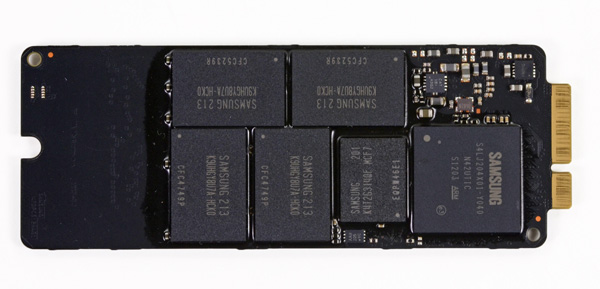
The Samsung PM830 based rMBP NAND flash storage card, image courtesy iFixit
My Retina MacBook Pro was the upgraded model with a 512GB SSD, featuring Samsung’s PM830 controller. This is the same controller as in the Samsung SSD 830, which I’ve long felt was the best pair for Mac users who wanted an SSD upgrade. I’m not sure if other Retina MBPs may come with Toshiba’s SandForce based drive instead. I have one of these drives in house for a review but that’ll have to wait until next week.
Although both the Samsung and Toshiba/SandForce controllers support full disk encryption, neither hardware based encryption is supported by OS X’s FileVault 2. When OS X encrypts your boot volume not all areas are encrypted (such as the recovery partition). While I know SandForce allegedly offers multiple encryption levels across a volume I’ve never seen either controller claim support for partially unencrypted volumes. In this case it looks like for Apple to take advantage of SSD controller based encryption it would need more flexible encryption support on the controller level. If I were an SSD controller vendor I’d be paying close attention to this requirement.
Both the Samsung and Toshiba controllers support 6Gbps SATA - as a result performance is significantly better compared to previous Apple branded SSDs. I borrowed a friend’s 2010 MacBook Pro which happened to have a Toshiba based SSD installed and ran it through our standard Iometer four-corners test suite. This was a well used drive and thus the performance is even worse than last year's MacBook Airs. The improvement in performance is astounding:
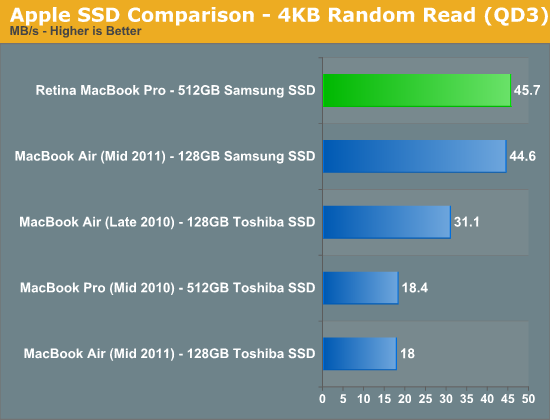
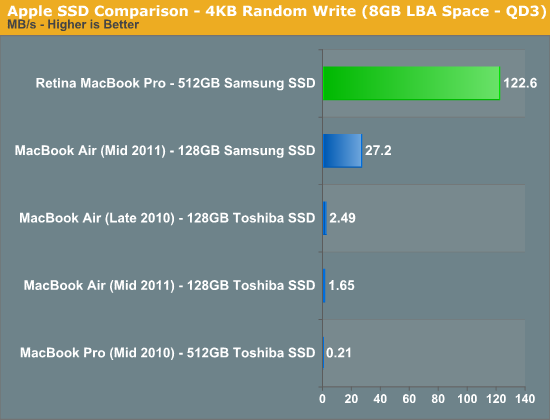
The move to 6Gbps SATA is often associated with a huge bump in sequential transfer rates, but in this case Apple enjoys a significant increase in random speeds as well. Note that some of this improvement is going to be due to the fully populated configuration of the PM830 in the Retina MacBook Pro's SSD, but that shouldn't downplay the significance of the move to Samsung's latest controller. The previous generation controller used last year just wasn't very good, and the Toshiba alternative was even worse. This year, Apple finally has a good solid state story to tell.
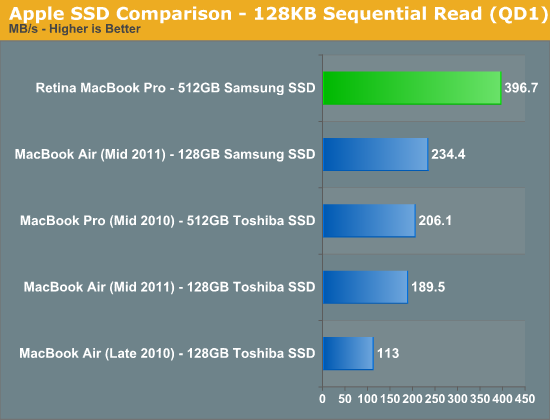
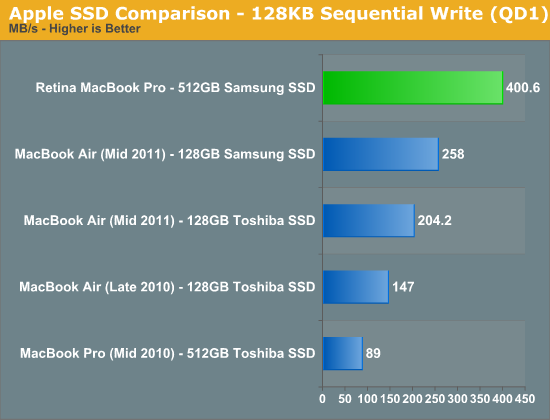
How much of this are you going to be able to actually tell in day to day use of the system? The sequential transfer rates are most tangible when you are writing to or reading large files like movies to your drive. Obviously you need a source that's fast enough to hit these speeds. Although USB 3.0 can come close you're unlikely to have a USB 3.0 SSD that's as fast as the internal drive. Moving large files between your internal SSD and Promise's Pegasus R4/R6 is where you'll really appreciate this performance.
The random access improvements are likely overkill for most normal uses. Things like program launches, compiling, web browsing, and any other normal application IO will depend on a mixture of random and sequential IO. The key is to have good enough random IO performance to avoid becoming a bottleneck. I can safely say that the numbers we see here are more than enough.
While previous Apple SSDs were nice only from a convenience standpoint, at least the Samsung option in the Retina MacBook Pro is what I’d recommend even if Apple didn’t bundle it with the machine.










471 Comments
View All Comments
rs2 - Monday, June 25, 2012 - link
...the $2200 one that doesn't include an optical drive and has nowhere to put one. It's not like I want my $2200 device to be usable as an impromptu blu-ray player or anything like that. No, I have money to burn buying extra appliances that do things that my pricey laptop should be able to do, but can't.That's what I might say if I had a hole in my head, at any rate.
rs2 - Monday, June 25, 2012 - link
Also, statements like this seem at least somewhat questionable:"The absence of an integrated Gigabit Ethernet port will surely bother some, but Apple offers a Thunderbolt to GigE adapter for $30 to accommodate."
So Apple leaves out a feature that many people would expect as standard in a high-end laptop, but it's okay because they also happen to sell an optional, paid add-on accessory that provides gigabit ethernet connectivity? Same goes for their $10 power-supply adapter cable.
How about calling them out for trying to nickel-and-dime people to death?
Fx1 - Monday, June 25, 2012 - link
God people like you make me sick.95% of people never used the ethernet port. i would rather than 25% shaved off the profile and weight. 10$ isn't much if your one of the sad people to have to use an ethernet.
Spending £2000 on a laptop I'm not going to care about £7 on a adapter
Spunjji - Tuesday, June 26, 2012 - link
Chill. Either you're sick a lot or you're being hyperbolic...Putting Ethernet in won't increase width by 25%. There are many, many ways to do it and there are thinner laptops out there that support it, even if using hideous dongles. Furthermore there are a wealth of legitimate reasons for wanting it.
Basically what I'm saying is, STFU noob.
Spunjji - Tuesday, June 26, 2012 - link
Yay for paying for baseline features! That adaptor should come as standard with a laptop this expensive. Their penny-pinching with respect to their actual margins is infuriating.ramb0 - Monday, June 25, 2012 - link
Thanks Anand, nice description of what's going on here with the Retina scaling.How is it possible that a 600x600 (for example) image looks better on the rMBP than it does on a standard MBP, and occupies the same amount of screen realestate?
I understand the Backing Scale of 2.0 draws the pixes 4 times more, so therefore appears the same size as on a 1440 screen, but i don't understand how this works for a .jpg image for example.
If it is just using pixel doubling, wouldn't the quality between the "retina" display and normal display be exactly the same, because it is just multiplying each pixel by 4. So essentially you end up with 4 pixels that are the same as each one.
Also, on a separate note, it would be great if you could set the text & UI elements in scale mode of 1680 x 1050 or 1920 x 1200, but keep the "work space" elements as native 2880x1800 (Backing scale 1.0).
wfolta - Monday, June 25, 2012 - link
As I understand it, the image will not look better. Images on disk, say, can look better (because you see pixels you couldn't have seen before). Some websites, like Apple's, will feed you higher-density images than if you were browsing with another machine, and obviously those will look better.Lepton87 - Monday, June 25, 2012 - link
Somehow I doubt that you would be so lenient towards any other company, but if there are glitches in apple hardware it's your fault by your own admission or someone else is at fault. Way to stay neutral and impartial.
Evil_Sheep - Monday, June 25, 2012 - link
Wow, a real bronze medal from Anand! Fewer of these are handed out than Olympic bronze medals in odd-numbered years. And all Apple had to do was innovate and ship a completely revolutionary computing paradigm in displays which, in stark contrast to its PC competition, works virtually flawlessly from day one right down to reprogramming minute graphics routines and on a topic Anandtech has been loudly harping on for years.But never let it be said that Anandtech is too generous with its awards.
Freakie - Monday, June 25, 2012 - link
Hey Anand, or any other employee of the website, aren't there a few parts of this review that very specifically break your traditional object reviews of products and hardware? I mean, it's fine to be excited about something, as Anand is obviously about this laptop, but I think he is so excited that the website's integrity is a little bit compromised. I realize that anyone from the website reading this will recognize that I don't have any right to speak about the integrity of an article written by Anand himself on his own website, but I feel like it should be said anyways, in hopes of keeping your minds clear and objective.It's just things like praising the fact that they got rid of an extra piece of glass on the screen, and how much praise Anand gave for this admittedly stupid thing to point out. As Anand said, this is a matte screen, not a glossy screen, so there being an extra piece of glass in the front would be completely ridiculous, right? The only mention of other matte screens is that those who have used a matte screen in the past are used to not having a protective piece of glass or plastic in between them and when the real LCD starts. Other than that, there isn't anything special about it not having that extra piece of glass. Yet it just baffles me how much Anand goes on about how it has magically been engineered away somehow.
Sorry if I sound pretentiously opinionated. I just really felt that the integrity and methodical reviews that so many people come to Anandtech.com for feels very lacking in this review >_<